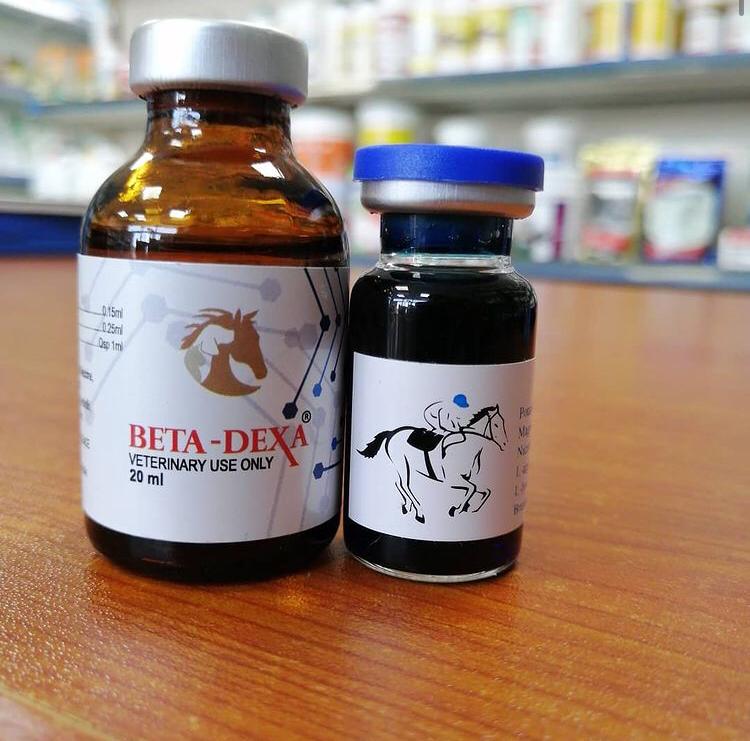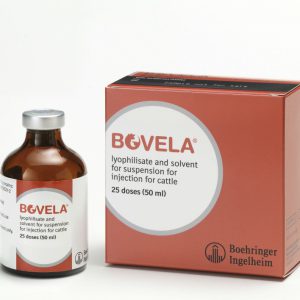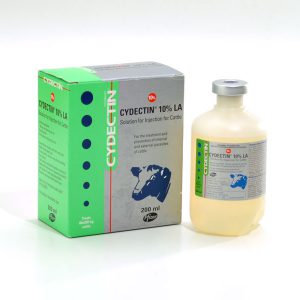Beta-Dexa. Anti-inflammatory glucocorticoid of high concentration and fast effect, for use in large and small animals.
Beta-Dexa (Dexamethasone 21 Disodium Phosphate), is a potent anti-inflamatory corticosteroid of maximum concentration and ultra fast action.
It is particularly suitable for emergency intravenous administration due to its high concentration in a small volume injected.
Pharmacokinetic
The drug circulates in plasma binding to transport proteins; the rest as a free hormone. Cortisol is conjugated in the liver with soluble glucoronates and sulfates, which are excreted by urine.
Bioactivity
Beta-Dexa (Dexamethasone 21 Disodium Phosphate), has an anti-inflammatory potency 30 times greater than cortisol and a relative mineralocorticoid activity of 0 with respect to 1 to 2 for the cortisol.
Its plasma half life is 119 to 300 minutes, and the duration of its effect after parenteral administration is greater after 48 hours.
Beta-Dexa has different effects on the different systems:
At the cardiovascular level, reduces the capillary permeability avoiding the vasoconstriction.
It has a positive inotropic effect, slightly increasing blood pressure.
At the renal level, fluids and electrolytes, increases the excretion of potassium and calcium, the reabsorption of sodium and chlorine and significantly the volume of extracellular fluid.
At the metabolic level, it stimulates the gluconeogenesis by raising blood glucose.
Increase liver glycogen stores.
At the cellular level, stabilizes cell membranes, inhibits the proliferation of fibroblasts, macrophages, lymphocytes sensitization and inflammation-mediating cells.
At the central and autonomic nervous system level, it decreases the response of the pyrogens, and stimulates the appetite.
At the hematopoietic level, increases the number of platelets, neutrophils and circulating erythrocytes.
Indications for use
Beta-Dexa (Dexamethasone 21 Disodium Phosphate), is indicated in the emergency therapy of various states of shock, anaphylaxis, bronchospasm, head trauma, spinal cord compression syndrome, spinal pain, neuralgia and neuropathies, arthropathies, myalgia and myopathies, tendonitis, bursitis, autoimmune disease, stress, anorexic syndrome and azoturia of the sport animal.
Beta-Dexa, may be used in dermatological or respiratory allergies, bronchial asthma, ketosis and as a labor inducing agent.
Beta-Dexa, has activity on microcirculation, producing a sustained vasodilatation by beta 2 adrenergic actions at capillary level, improving tissue and renal perfusion, protecting tissues from hypoxia and acidosis stabilizing the lysosomal membranes. This activity makes it a drug of special use in the stabilization of the patient in shock.
Beta-Dexa, is recommended for its use in cattle, horses, sheep, swine, dogs and cats off all breed, sex and ages.
Compatibilities
Beta-Dexa for injection is compatible with amikacine sulfate, aminophyline, bleomycine sulfate, cimetidine, Glycopyrrolate and Lidocaine hydrochloride.
Compatibility depends on the pH, concentration, temperature and diluents used.
Incompatibilities
Beta-Dexa is incompatible with doxorubicin, daunorubicin and vancomycin.
Routes of application
Parenteral injection, subcutaneously, intramuscularly, intravenously bolus or by infusion, intraarticular, perineural or local infiltrative.
Dosage
Reference dose for shock states (all species): 4 to 8 mg/kg (equivalent to 2 to 4 ml/10 kg). Intravenous route.
Horses, cattle, sheep and swine: 0.05 to 0.2 mg/kg (equivalent to 0.125 to 0.5 mL/50 kg). Intravenous, intramuscular or subcutaneous route.
Dogs and cats: 0.1 to 2 mg/kg (equivalent to 0.05 to 1.0 mL/10 kg). Intravenous, intramuscular or subcutaneous route.
Reference dose according to different clinical uses
Hypovolemic shock or dehydratation: 4 to 8 mg/kg Intravenous, simultaneously with fluid therapy and balance of the internal environment.
Anaphylactic shock: 4 to 8 mg/kg intravenously.
Therapeutic support in shock due to acute gastric dilatation, volvulus or intestinal torsion: 3 mg/kg intravenously.
Prevention of endotoxic shock: 5 mg/kg slow intravenous route.
Bronchial Asthma, allergic bronchitis: 0.25 to 1.0 mg/kg 1 to 3 times per day.
Acquired thrombocytopenia (CID): 0.25 to 0.3 mg/kg intravenous or subcutaneous route one application, then continue with 0.1 to 0.15 mg/kg twice a day during 7 days.
Craniocerebral and/or spinal trauma: initially administer 2 mg/kg intravenously, and then continue with 0.2 mg/kg two to three times per day.
Spinal trauma, dislocated disc with paresia, spondylopathies: Administer from 2 to 3 mg/kg intravenously within 6 to 8 hours of trauma, continue with 1 mg/kg two to three times a day subcutaneously or intramuscularly during the next 24 hours, continue for 2 to 3 days with 0.2 mg/kg every 12 hours and then for 3 to 5 more days with 0.1 mg/kg every 12 hours.
Induction to parturition or therapeutic aborts:
- Aborts: 25 mg/kg combined with 25 mg of F2 Alpha Prostaglandine, after 150 days of gestation (Cattle and Horses).
- Labor induction: Up to 2 weeks before the tentative date of parturition, administer 20 to 30 mg intramuscularly.
Intracranial edema: 0.25 to 2.0 mg/kg to 6 hours intravenously.
Hydrocephalus: 0.25 mg/kg three to four times per day. Gradually reduce the dose after 2 to 4 weeks of treatment.
Fibrocartilaginous myopathies or post traumatic adhesions: 2.2 mg/kg every 6 to 8 hours subcutaneously, then continue with 0.1 mg/kg every 12 hours for 3 to 5 days.
Paresis of the obturator and/or fibular nerve: 10 to 30 mg, once a day, for 2 or 3 days. Subcutaneous or intramuscular route.
Aseptic laminitis: 5 to 20 mg/kg intravenously or intramuscularly once a day, during 2 or 3 days.
Ketosis: 5 to 20 mg/kg intravenously or intramuscularly.
Contraindications and limitations of use
- The use of systemic corticosteroids is generally contraindicated in fungal, viral and bacterial infections in which the relevant antibiotic therapy has not been established
- In prolonged treatments, the recovery times of ACTH induction should be taken into account, whose function will slowly normalize after discontinuation of the treatment.
- It should be remembered that high doses of corticosteroids in the last third of pregnancy can induce parturition, occasionally followed by this effect dystocia, fetal death, placental retention and metritis may occur.
- Do not administer to animals suffering from uremic syndrome, glaucoma, diabetes, mellitus, acute infosura, ulcerative processes in general, tuberculosis, paratuberculosis, leptospirosis in nesting stage and in vaccination periods.
- Do not use in lactating dairy cows whose products are intended for human consumption.
Side Effects
Side effects are normally associated with prolonged treatments, especially at high doses without respecting the indication of alternate days. Symptoms manifest as hyperadrenocorticism.
In young animals it can delay growth. In dogs, effects such as polydipsia, polyuria and polyphagia are described. Adverse effects in dogs are related to sadness, weight gain, coat change, vomiting or diarrhea, elevation of liver and pancreatic enzymes, gastric ulcers, behavior changes and exacerbation of diabetes mellitus. This symptomatology is reversed by simply discontinuing the administration of corticosteroids.
Teratogenic effects are described in massive treatments in females with early pregnancy (cleft palate, bone deformation)
It is rare to find side effects that escape polydipsia, polyuria and transient polyphagia, when the drug is administered as an ultra-short- acting anti-inflammatory agent.
Suggestions
It is suggested not to vaccinate animals that are under prolonged treatment with corticosteroids, or if necessary it should be revaccinated once it is finished the treatment.
Precautions
All routine aseptic and antiseptic measures regarding the product and the animal should be taken, in order to preserve its sterility, chemical contamination and prevent accidents after the application maneuver.
The suggested doses and warnings in all cases are for the consideration of the acting veterinarian.
Verify that the product inviolability system and its storage conditions prior to use are adequate.
Storage
The appropriate temperature for the correct conservation of the product is between 15 and 30ºC, protected from direct sunlight, kept in a dry and hygienic place.
Recyclable container, destroy after use and throw in waste collectors and not in the field or public roads. Protect the environment. Do not eat. Keep out of the reach of children and domestic animals.
UNDER VETERINARY PRESCRIPTION ONLY
Beta-Dexa: 20 mL vials of sterile injectable solution.https://kihorsemed.com/





Reviews
There are no reviews yet.